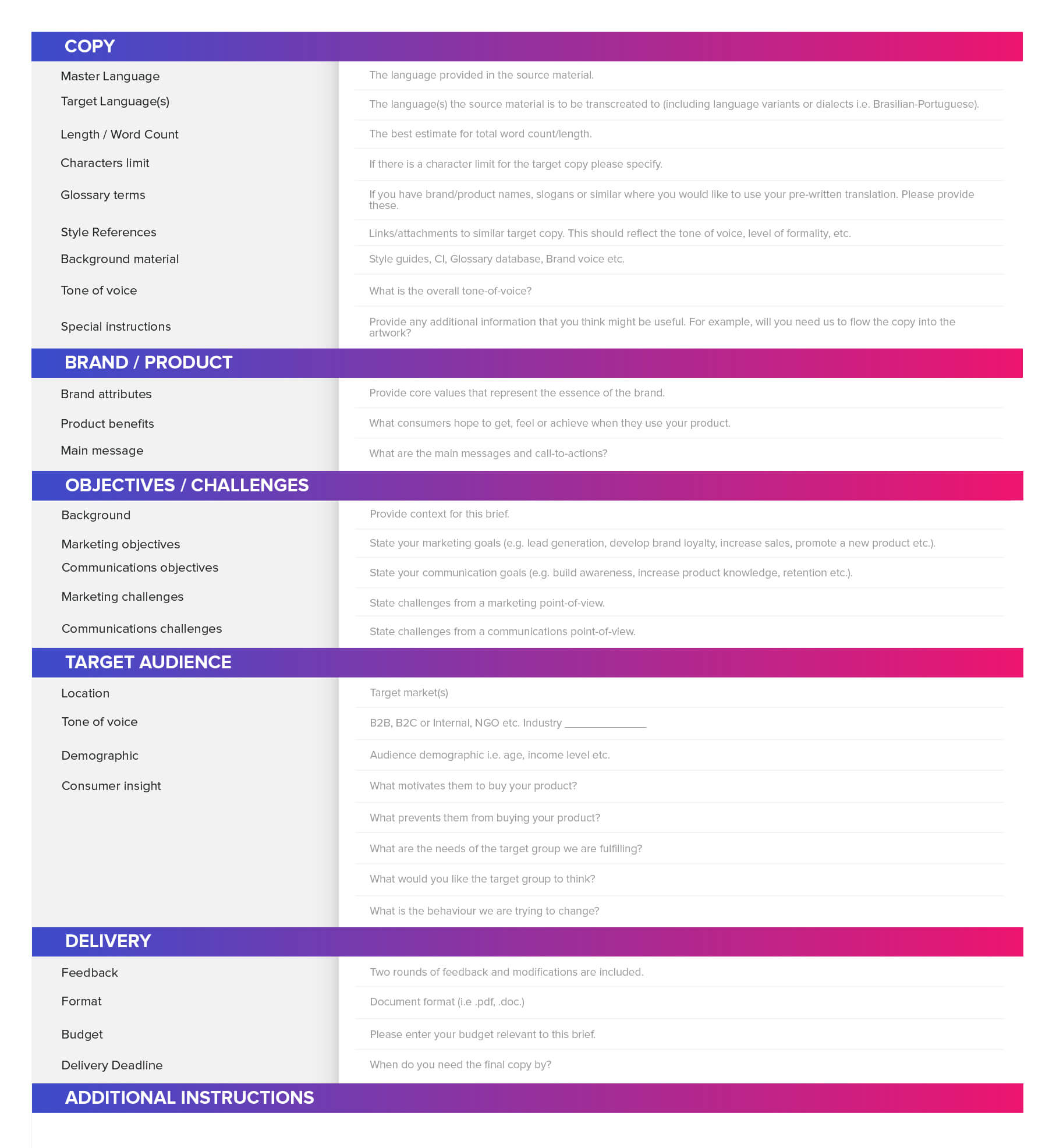
One of the most important responsibilities of product management is to protect a brand’s image. Therefore, hiring translation and transcreation suppliers takes a thorough investigation. Here are some factors to consider.
How to hire
Be sure to hire a translator/copywriter with extensive experience in their field in order to ensure that the quality of your message is communicated across various markets. Transcreators should also have marketing experience on top of their writing skills to fully understand when and how marketing and advertising communications are effectively delivered to target audiences.
Transcreation should only be performed by native speakers of the target market. It is vital that idioms and jargon, as well as humour and other emotions, in the local regions are used organically in the target copy.
Transcreation suppliers should fully understand the culture of the target audience, including the market, buying behaviours, income levels, shopping preferences and needs.
These are useful tips to evaluate when starting a transcreation project. However, it is also important to understand the transcreation process. This will also help in choosing the right transcreation provider and, in the long run, save money on expensive transcreation services that do not meet the campaign’s requirements.
- Machine Translation - Free
- Translator non-professional - $
- Translator professional - $$
- Transcreator professional - $$$
- Copywriter professional - $$$$
1. Understand the content
Transcreation is not needed for all marketing content. Transcreation should mostly be used in creating headlines, taglines and for elements like humour, idioms, puns or jargon because it can effectively recreate a certain style and voice. Marketing teams should relay whether certain language, images, colours or idioms can resonate in target markets. It is useful to do market research and discover how competitors communicate in the same region. Identifying trends is also useful in creating transcreation on the local level.
Successful transcreation caters to the target audience. Therefore, understanding and describing the target audience can help suppliers provide effective results. If the transcreator does not clearly understand whom they are writing for, they may miss the mark.
2. Find out timeframe and price
Transcreation should not be rushed. Therefore, transcreation work should be planned before launching campaigns into target markets. Naturally, the timing coincides with the amount of materials needed and in how many languages. It is important to first identify the target languages and types of materials needed before discussing deadlines with transcreation providers. Factor in reviews and revisions in the timeline before the final delivery.
3. Create a checklist or transcreation brief
The success of transcreation projects depends greatly on the cooperation between marketers and providers. Marketers should communicate requirements and expectations so there is no confusion on the provider’s end.
Before beginning the project, marketers must provide all source materials that need transcreation work and brand guidelines. Also, it is important to take timing into account, since proper and effective transcreation should not be rushed. Realistic goals should be set between clients, agencies, providers and any other players in the project.
The transcreation team should receive a brief detailing the campaigns goals, context, target markets, target audiences, key messages and languages required. Afterwards, it is up to the transcreation providers to recreate content that will be successful in the target markets.
4. The transcreation process
After initial planning, the chosen provider begins its transcreation work. The steps include reviewing and understanding the creative brief or checklist. Then, they must identify similarities or differences between the source market’s consumer behaviour, culture and language and those of the target market. After their analysis, the transcreator will have valuable insights to help them recreate appealing content that will achieve desired reactions from the target audience. The first round of content will then be delivered for review. Feedback will be sent back to the transcreation provider to finalise the content.
5. Testing of the new content
If marketers want to test the transcreation content, they can provide consumers with a survey or platform designated for feedback. It is important to evaluate whether the cultural nuances or language subtleties have been addressed and the target audience is reacting well with the new, transcreation content. Marketers can make adjustments or changes during the testing period in order to create the most effective messaging.
Once the first version of the transcreation copy is completed, a reviewer from the target region should take a look at the materials. The reviewer should understand marketing, as well as the product or service being promoted. The reviewer should pay particularly close attention to the tone of voice, terminology, expressions and decide whether the message is communicated effectively to the target audience. A second reviewer may be employed to determine whether all of the transcreation assets are necessary. Once the original messaging is recreated on the local level, it’s time to design the transcreation copy.
At this stage, the design work contains two crucial elements:
Typesetting: Designers must fit the new copy into the original layout and format, making sure there are not jarring line breaks or spaces.
Visual elements: Colours and graphics that resonate well within some markets may not perform so well in others. The transcreation provider can explain what works best in their target market, choosing the most culturally appropriate elements for successful localisation.
Let’s look at an example. In the UK, blue is often linked to sadness, as one having “the blues”. However, in the Middle East, blue has connotations of safety and protection and has symbolism in heaven, spirituality and immortality.
”Clients understand every element of their brand, such as values, goals, requirements, messaging and so forth. But, they must be careful not to assume that transcreation providers share this understanding.”
Creating a Brief
Creating the most effective transcreation marketing content is vital since unsuccessful reactions from target audiences can have a huge negative impact on global campaigns. Content that does not sit well with local audiences can affect a brand’s overall reputation, let alone their campaign goals. A helpful way to avoid transcreation problems is to provide a clear and concise brief.
Clients understand every element of their brand, such as values, goals, requirements, messaging and so forth. But, they must be careful not to assume that transcreation providers share this understanding. The more information the clients offer the provider, the more in line the transcreator will be in delivering the most effective copy. Briefs should be organised and easy-to-understand. They should begin with general info about the brand and the campaign and moving on to specifics.
Background
Briefs should start off defining the brand (providing the brand’s background): Who is the brand? What does the brand stand for?
Next, the brief should have specifics: Is this a new product or campaign launch? What is the reason for this campaign?
The background is important for providing context about the brand and project, and gives the transcreation team more information to work with.
Objective
Next, the brief must document clear objectives so that the transcreation team knows exactly what this campaign sets out to achieve. Transcreation writers should receive as much information as possible. So, for example, if objectives are to target new customers or build brand awareness, it should be clearly written in the brief.
Specifications
Part of the brief should document the specifics of the campaign, including the target audience, proposed media channels, subject matter expertise, amount of copy, source and target languages and so on. Inconsistencies or vague subject matter can reduce the effectiveness of the transcreation copy. For example, if the brief does not clearly describe the target audience, the transcreation content may not resonate with its intended consumers. To make this clear, information like age, gender, location, social position, occupation and more should be added to the brief.
The tone of voice should also be made clear in this section. That way, the transcreation materials will align with how the brand communicates with its audience. Transcreators can develop assets according to these criteria, allowing marketers predict and evaluate the audience’s reactions – and, perhaps, adjust where needed.
Budget, Timelines and Reference Material
Briefs must clearly express the final budget and deadlines that the transcreator must meet. Any additional references should also be provided in the brief that can help the transcreator develop appropriate and effective copy.
Transcreation Brief
This brief is to give in-market based transcreators a detailed insight into the target copy in order to ensure the meaning of the master copy is accurately portrayed in the final output and the copy speaks to the local audience, both culturally and linguistically.





